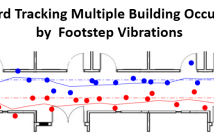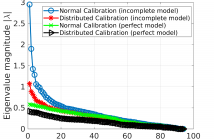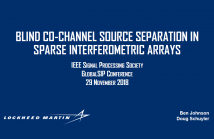
- Read more about MIMO RADAR TRANSMIT BEAMPATTERN SYNTHESIS VIA WAVEFORM DESIGN FOR TARGET LOCALIZATION
- Log in to post comments
- Categories:
 15 Views
15 Views
- Read more about TOA SOURCE NODE SELF-POSITIONING WITH UNKNOWN CLOCK SKEW IN WIRELESS SENSOR NETWORKS
- Log in to post comments
This paper investigates time-of-arrival (TOA) source node self-positioning with unknown clock skews in wireless sensor networks. For the source-to-anchor direction, source node clock skew does not affect the localization performance. When synchronized anchor nodes simultaneously transmit signals to a source node,the source node clock skew will degrade the localization performance.
- Categories:
 16 Views
16 Views
- Read more about Occupancy pattern recognition with infrared array sensors: A Bayesian approach to multi-body tracking
- Log in to post comments
- Categories:
 64 Views
64 Views
- Read more about TRANSMISSION DESIGN FOR A JOINT MIMO RADAR AND MU-MIMO DOWNLINK COMMUNICATION SYSTEM
- Log in to post comments
We study a cooperative transmission scheme for a joint multiple-input-multiple-output (MIMO) radar and multi-user (MU) MIMO downlink communication system, where both systems operate on the same frequency band simultaneously. Maximization of the total weighted system mutual information or sum rate is considered with the presence of an extended target and environmental clutter. An alternating optimization based iterative algorithm is proposed to find the transmit covariance matrices for both radar and communication applications.
GlobalSIP.pdf
- Categories:
 38 Views
38 Views
- Read more about Toward Tracking Multiple Building Occupants by Footstep Vibrations
- Log in to post comments
Several researchers recently demonstrated that it is feasible to locate building occupants solely from measured footstep vibrations. The research reported here applies that capability to track multiple building occupants in motion. In contrast to many indoor tracking methods based on wireless technology, this method frees individuals from the need to carry a device, and, furthermore, permits localization and tracking in facilities that restrict or prohibit wireless devices or cameras.
- Categories:
 22 Views
22 Views
- Read more about Sine-based EB-ESPRIT for source localization
- Log in to post comments
The eigenbeam-ESPRIT (EB-ESPRIT) is well known as a high-resolution parametric direction-of-arrival (DOA) estimation technique for a spherical microphone array. Unlike other eigenbeam beamformers such as EB-MVDR and EB-MUSIC, there is no need for exhaustive grid-search with EB-ESPRIT. However, when sources are positioned near the equator, the EB-ESPRIT inevitably induces a singularity problem due to the singularity of its tangent function utilized as a directional parameter. Here, a new EB-ESPRIT technique based on a nonsingular directional parameter is proposed.
- Categories:
 93 Views
93 Views
- Read more about A Multi-Channel Partial-Update Algorithm for Sea Clutter Suppression in Passive Bistatic Radar
- Log in to post comments
Sea clutters with Doppler-varying spectrum exert a
notable negative impact on the detection performance, especially
with low-velocity targets, when a passive bistatic radar is employed
to detect sea-surface targets. One feasible solution is to
modulate the reference signal onto the Doppler dimension and, as
such, a filter with a wide notch and sharp edges can be obtained
to suppress the residual clutters. However, to achieve this goal, a
considerably high computational complexity is demanded in the
- Categories:
 44 Views
44 Views
- Read more about Performance analysis of distributed radio interferometric calibration
- Log in to post comments
Distributed calibration based on consensus optimization is a computationally efficient method to calibrate large radio interferometers such as LOFAR and SKA. Calibrating along multiple directions in the sky and removing the bright foreground signal is a crucial step in many science cases in radio interferometry. The residual data contain weak signals of huge scientific interest and of particular concern is the effect of incomplete sky models used in calibration on the residual. In order to study this, we consider the mapping between the input uncalibrated data and the output residual data.
lofar75.pdf
lofar75.pdf
- Categories:
 5 Views
5 Views
- Read more about Constant Envelope Transceivers in Millimetre-Wave Massive MIMO: EVM and Link Budget Considerations
- Log in to post comments
RF 30 GHz ray-tracing simulation results are presented from a conceptual, Massive- Multiple Input Multiple Output (M-MIMO) propagation model in an urban canyon. The usage of Constant Envelope (CE) RF signals is evaluated in both
- Categories:
 8 Views
8 Views